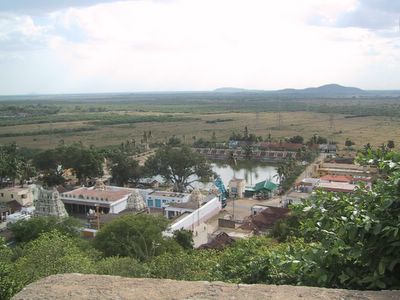
Moolavar is with right arm in abhaya mudra and left arm is kati hastha. Alwars have regarded the Lord here as Sri Venkatesa of Thirumala. Utsavar is also having right hand in abhaya mudra. Along with Sri Sridevi and Sri Bhudevi, Sri Neervanna Perumal is gracing.
When worshiping, we can observe that the Lord's mind like turbulent water. Water. though disturbed, gets cleared now and then. The Lord is quite clear in protecting the Universe. Same Lord gets disturbed at times when seeing the plight of His devotees. When Thirumangai Alwar visited this place, it was surrounded by water. So, he waited for the water to drain, for about Six months. Then only he could visit the temple and sing in praise of the Lord, as Sri Neervannan , Sri Neelavannan and Sri Neer Mukilvannan. Now we will see sloka 1 of Chapter 12:
arjuna uvaca
evam satata-yukta ye
bhaktas tvam paryupasate
ye capy aksharam avyaktam
tesham ke yoga-vittamah
"Arjuna inquired: Which are considered to be more perfect, those who are always properly engaged in Your devotional service or those who worship the impersonal Brahman, the unmanifested?"
Arjuna says to Sri Krishna that he had heard of Two types of persons; one, those who meditate on atman, with the desire to enjoy atman, and who are called Kailvayarthi [கைவல்யார்த்தி] or atma prapti kama [ஆத்மா ப்ராப்தி காமர்கள்]. We have already discussed this in Chapter 7, where Sri Krishna mentioned about Three types of devotees : Aiswarya artis [ऐस्वर्यार्थी, desirous of worldly pleasures using sensual organs], Kaivalya artis [कैवल्यार्थी, desirous of enjoying their own souls and not wanting to have rebirths, doing only Karma yoga and Gyana yoga] and Bhagavallabha artis [भागावल्लाभार्थी, desirous of serving the Lord in Vaikuntam for ever, using Bhakti yoga]. Arjuna leaves the First category of Aiswaya artis, and wants clarification on the other Two, viz., Kaivalya artis and Bhagavallabha artis. This has been already dealt with by Sri Krishna in Chapter 7, where He has categorically said that of all the devotees, the Lord likes most only those who practice Bhakti yoga. So, here what Arjuna asks is not who is better among the Two types of devotees. That has been already settled. Here what Arjuna asks is among these Two categories of devotees, who attains the objective first. In a running race, when Two persons are competing, race will be won by either speed or the terrain, which could be different. Evam = therefore, satatam = always, yukta = desiring to be with [the Lord, as mentioned by the Lord in the last slokas of Chapter 11], ye bhakta = those devotees [who have chosen Bhakti yoga], paryupasate = practicing total meditation of, tvam = You [Sri Krishna]. This is one category of devotees, who always desire to be associated with the Lord and so are in Bhakti yoga. The other category is those who desire to enjoy their own souls always. Ye capy = whereas the other category [of devotees], aksharam = indestructible, avyaktam = not perceptible by senses, both these qualities are about atman or soul. There are persons who want to meditate on the everlasting soul; and, there are those, who desire to be meditating on the Lord to be always with Him. Tesham = among them, ke = who, yoga vittama = attains first [the objective]? Here we should note one thing. Both are devotees of the Lord. Kaivalya arthi requires the help of the Lord only to reach his goal of enjoying his own soul. After, attaining that, he is no longer in need of the Lord. This is called sadhana dasa [साधन दशा ] Bhakti. On the other hand, the Bhagavallabha arti, needs the Lord to reach his goal of Vaikuntam and after that he wants to be with the Lord serving Him in Vaikuntam also. He is having both sadhana dasa Bhakti and sadhya dasa [साध्य दशा ] bhakti. He desires the association of the Lord both during efforts and also after reaching the end result. This difference is indicated in the words satata-yukta, by the Lord. We should decide to which category we have to follow: Kaivalyaarti, clinging to the Lord only half way through, or, Bhagavallabha arti, who clings to the Lord for ever? [In the last few minutes of the lecture there were frequent disturbances of no signal and so audibility was interrupted many times]
1 comment:
In the translation of slokas of gita the method followed is not according to Vaishnava Siddaantam. for example in this sloka "those who worship impersonal brahman" is used. but according to the translations of puthur sri krishnaswami iyengar "jeevathma swaroopa upasanam" that those are kaivalyarthi Athmopasagargal. arjuanan asks who will attain their purushaarththam: one is those who are Bhagaval laparthi and those who are AthmOupasagargal. ie jeevathma upasagargal.
in your translation of swami Velukudi talk is also like this
sri uttamanur seami translation also like this. nirguna brahaman is of Advaita philosophy.
adiyen written something according to my understanding form reading the books.
you have done a wonderful kainkaryam. but just some corrections required.
Post a Comment